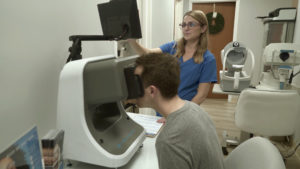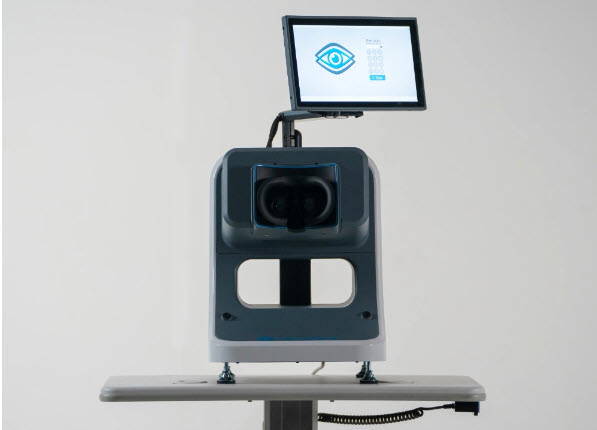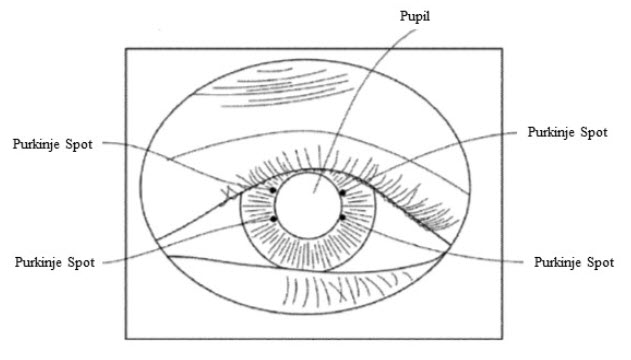
Photo courtesy of Neurolens. A patient is tested using the measurement device nMD2.
By the NECO Innovation Center
Beneath the purview of Gary Y. Chu, OD, MPH, FAAO, Vice-President, Professional Affairs
Nov. 30, 2022
Digital vision syndrome, also referred to as computer vision syndrome, was identified through clinical observations and has become a topic of discussion in optometric journals and courses. It has been defined as the physical and eye discomfort felt by individuals after two or more hours using a digital screen.1 These symptoms, ranging in severity, include eye strain, diplopia, dry eye sensation, headaches and neck tension.
A series of studies conducted by Neurolens, a designer of visual alignment measuring instruments and lenses that correct misalignment, concluded that computer vision syndrome symptoms were associated with misalignment between the eyes. In order to improve symptoms, the ocular misalignment needed to be corrected at distance and near.2
The Neurolens concept was conceived after a disgruntled patient in a group practice complained about his new glasses causing headaches and requested not to be examined again by the “young doctor” in the practice. After being examined by the more experienced doctor, it was determined that the care had been appropriate, but a key issue causing his symptoms had been overlooked. He used the Turville Infinity Balance technique3, a method of monocular refraction and binocular testing under dissociated binocular conditions that was developed in the 1940s, to identify the alignment issue causing the problem.4 (A similar method using crossed polarized filters for each was developed in Israel in the mid-1990s.5) This led to a journey that developed the Neurolens measuring device and lenses.
Overview of the Technology
Recognizing that prism can be an effective way of caring for adult patients with near symptoms6, the Neurolens team worked to develop an instrument to objectively determine and measure binocular alignment. Their goal of developing an instrument to efficiently, objectively and accurately measure misalignment with reproducible results produced a device that rapidly takes 10,000 objective measurements of fixation disparities while accounting for central and peripheral vision in its measurements.
Their latest generation measuring device, the nMD2, incorporates patented technology7 which objectively measures the dissociated phoria of each eye at an apparent distance to determine accommodative convergence. The device has four main components.

Figure 1: Neurolens nMD2 Measuring Device
1. A stereo display to project images of each eye to create fusible and non-fusible images. This controls what each eye may be able to see and view at any point in time using a combination of static and dynamic imaging, as well as central and peripheral images.
2. A phoropter in the system is used to modify the projection of the images according to an apparent distance.
3. Eye trackers are used to determine the orientation of each eye. The nMD2 has four infrared light-emitting diode (IR LED) beams that illuminate each eye. The eye tracker uses infrared (IR) telescopes and IR cameras to detect the IR beams and the reflected IR Purkinje images from the four quadrants of the cornea. The image recognition system determines the orientation of each eye to objectively measure the alignment, based on the horizontal, vertical and cyclo-rotational orientations of the eyes.
 Figure 2: Position of Purkinje spots projected by the four IR LED Imaging Lights
Figure 2: Position of Purkinje spots projected by the four IR LED Imaging Lights
4. The computer system manages the stereo display, accommodative optics and the eye tracker, and analyzes the effect produced by changing the visual stimuli under static and dynamic visual conditions at a variety of distances, and controls the central and peripheral stimuli. The result is a precise and repeatable determination of binocular alignment.
Using objectively measured distance and near interpupillary distances, the nMD2 then provides a unique, objective measurement of functional misalignment at distance and near. It also provides a calculated contoured prism prescription.
Other Articles to Explore
What ODs Think
It is increasingly evident that patients want relief from digital vision syndrome. There have been many cases demonstrating the success of using objective measurements obtained by the nMD2 device to determine contour prism prescriptions and providing patients with symptom relief or improvement. The nMD2 is straightforward to use and has an 80 percent smaller footprint than previous models. Testing takes approximately two minutes, 35 percent faster than the nMD1.
Most ODs using the nMD2 are primary care optometrists. The ability of the device to obtain objective, accurate and reproducible measurements that result in small prism correction does not require the skills of an optometrist specializing in vision therapy.
Final Thoughts
The Neurolens nMD2 is an innovative device that is well-designed and manufactured. Its patented technology is impressive and has opened up a new approach to relieving an increasingly frequent visual complaint. Early skepticism about the device and its lenses is abating as both doctors and patients have recognized its success. There is growing awareness of the science behind the development of the device and the understanding that minor ocular misalignment can cause a multitude of symptoms that significantly debilitate patients who have digital vision syndrome. There is still more to learn. Additional studies by both Neurolens and independent groups are needed.
References
1. Computer Vision Syndrome, American Optometric Association. Accessed 11/1/2022.
2. V. Thompson, Eye pain and Strain that Masquerade as Dry Eye, Cataract and Refractive Surgery Today, Feb 2019. Accessed 11/1/2022.
3. MW Morgan, The Turville Infinity Binocular Balance Test, The Australasian Journal of Optometry, 1949;32:367-380.
4. K Mastrota, T Tranh, J Krall, F Mahgoub, Roundtable Discussion – Inside the Innovator’s Mind, Modern Optometry, March 2022, accessed 11/1/2022
5. IJ Shapiro, Parallel-Testing Infinity Balance, Optom Vis Science, 1995;72:916-923.
6. B Teitelbaum, Y Panf, J Krall, Effectiveness of Base in Prism for Presbyopes with Convergence Insufficiency, Optom Vis Sci, 2009;86:153-156.
7. J Krall, A Plumley, Patent Application: Method and system for measuring binocular alignment, Sept 2019, https://www.patentguru.com/US10420467B2. Accessed 11/1/2022

























